-
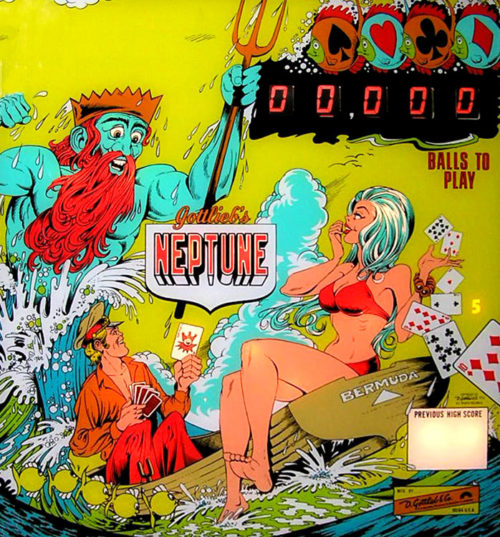 This rare add-a-ball game was released in April. It was designed by John Osbourne with artwork by Gordon Morison. A minimal total of 270 units were soldered together at the time. This is a small number for a pinball run. The replay version had a much larger production and the name of that game was Hit The Deck. As you can see from the backglass, Gottlieb tried to experiment with a score reel that was completely different in coloring. This was to attract attention to the game and attract quarters. The object of the game is to roll over the red number and/or black number sequence inherent in the game. If you are skillful enough to get the 9 to Ace sequence, some wow options will light up to score extra balls. A kickback feature is incorporated into the game in the upper-left area. This single-player game is challenging and a rare sight to see.
This rare add-a-ball game was released in April. It was designed by John Osbourne with artwork by Gordon Morison. A minimal total of 270 units were soldered together at the time. This is a small number for a pinball run. The replay version had a much larger production and the name of that game was Hit The Deck. As you can see from the backglass, Gottlieb tried to experiment with a score reel that was completely different in coloring. This was to attract attention to the game and attract quarters. The object of the game is to roll over the red number and/or black number sequence inherent in the game. If you are skillful enough to get the 9 to Ace sequence, some wow options will light up to score extra balls. A kickback feature is incorporated into the game in the upper-left area. This single-player game is challenging and a rare sight to see. -
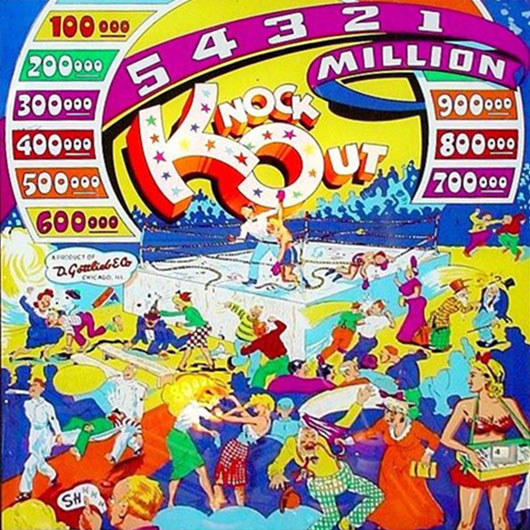 This game was produced in December of the year and designed by Harry Mabs with artwork by Roy Parker. 3,000 of these machines were made. The unique feature built into this machine is the animation unit in the top center of the play field. Two mechanical men are represented as boxers in a boxing match. Lights illuminate the bout when a knockout is scored by rolling over a “KO” rollover, a “KO” target, or completing bumpers 1 to 5. This game is one of the first examples of pinball animation. Another feature of the game is the pop-up bar at the bottom of the play field, preventing you from losing your ball in play for an extended period. Since the gap between the flippers is so massive, this addendum to the play field was installed to prolong the play period of the ball. A special feature is included in the game as well as a replay if 15 knockdowns are scored in one game and a replay for every knockdown scored thereafter.
This game was produced in December of the year and designed by Harry Mabs with artwork by Roy Parker. 3,000 of these machines were made. The unique feature built into this machine is the animation unit in the top center of the play field. Two mechanical men are represented as boxers in a boxing match. Lights illuminate the bout when a knockout is scored by rolling over a “KO” rollover, a “KO” target, or completing bumpers 1 to 5. This game is one of the first examples of pinball animation. Another feature of the game is the pop-up bar at the bottom of the play field, preventing you from losing your ball in play for an extended period. Since the gap between the flippers is so massive, this addendum to the play field was installed to prolong the play period of the ball. A special feature is included in the game as well as a replay if 15 knockdowns are scored in one game and a replay for every knockdown scored thereafter. -

-
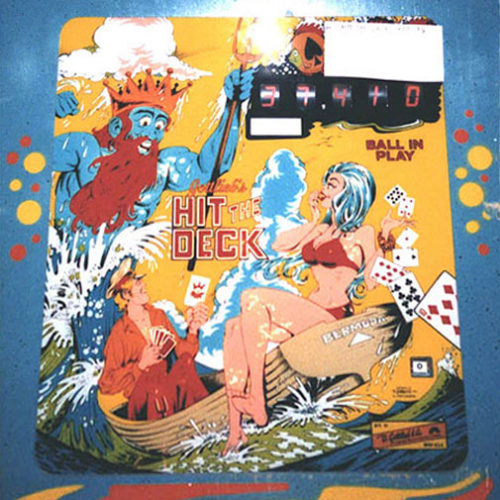
-
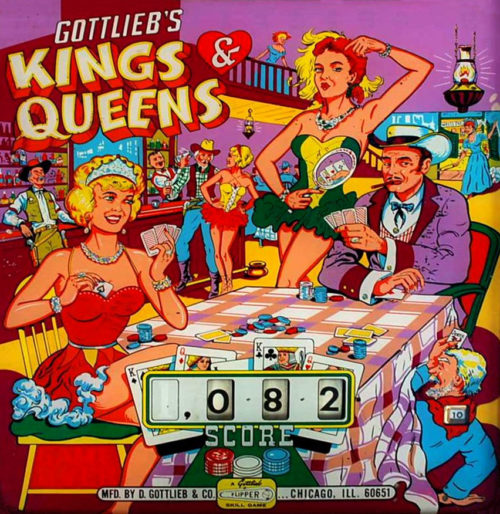 This game is a classic and is rated # 5 in collectible machines of the ‘60s. The game was created by Wayne Neyens with artwork by Roy Parker. Production run was 2,875 units. The main action in the game comes from the four in-line kickout holes set across the center playfield. The object of the machine is to hit a suit of four cards vertically under the kickout holes. If you get all four, a hole will randomly light up to score a free game (i.e., a special). The challenge here is to sink the ball in the kickout holes once a special is lit. All four holes can light up if you’re lucky enough to score all 16 cards. Finally, another special in the top rollover lanes randomly lights if you score just the four top cards on the pattern of cards. Score also was a factor as dropping balls in the kickout holes with many cards lit scored a lot of points very quickly.
This game is a classic and is rated # 5 in collectible machines of the ‘60s. The game was created by Wayne Neyens with artwork by Roy Parker. Production run was 2,875 units. The main action in the game comes from the four in-line kickout holes set across the center playfield. The object of the machine is to hit a suit of four cards vertically under the kickout holes. If you get all four, a hole will randomly light up to score a free game (i.e., a special). The challenge here is to sink the ball in the kickout holes once a special is lit. All four holes can light up if you’re lucky enough to score all 16 cards. Finally, another special in the top rollover lanes randomly lights if you score just the four top cards on the pattern of cards. Score also was a factor as dropping balls in the kickout holes with many cards lit scored a lot of points very quickly. -
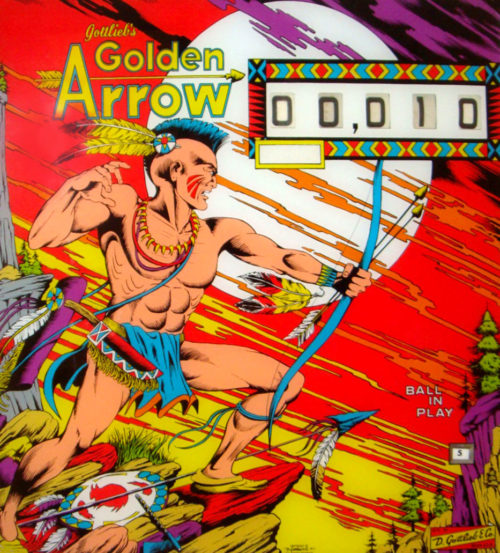 Here’s another example of a Gottlieb single-player mechanical game when all the other manufacturers during this period were developing solid-state computerized machines. Ed Krynski is the designer with Gordon Morison the artist of choice for this model, one of 1,530 machines made. The machine itself is a classic ’70s. Ten numbers is your goal here. You achieve these ten targets by hitting and rolling over the appropriate spots on the playfield. Hitting the spinner spots the numbered target the spinner stops on. If you’re lucky to complete the targets, the special lights up and advances through the ten numbers. Hitting the lighted number with “special” lit means more free time playing the game. Score for replays is your second goal. Nice artwork in a single player game, one of the last produced.
Here’s another example of a Gottlieb single-player mechanical game when all the other manufacturers during this period were developing solid-state computerized machines. Ed Krynski is the designer with Gordon Morison the artist of choice for this model, one of 1,530 machines made. The machine itself is a classic ’70s. Ten numbers is your goal here. You achieve these ten targets by hitting and rolling over the appropriate spots on the playfield. Hitting the spinner spots the numbered target the spinner stops on. If you’re lucky to complete the targets, the special lights up and advances through the ten numbers. Hitting the lighted number with “special” lit means more free time playing the game. Score for replays is your second goal. Nice artwork in a single player game, one of the last produced. -
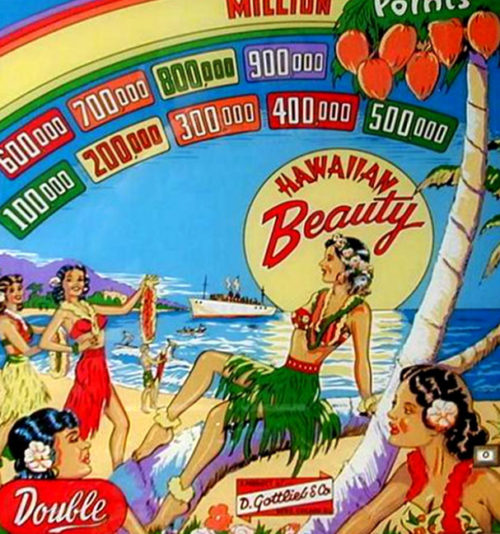 If there was a very pretty game manufactured in the ‘50s, this is it! Hawaiian Beauty was designed by Wayne Neyens with art package by none other than Roy Parker. 900 of these machines were screwed together in the Chicago factory. The game was initially called “Monkey Shine” but was later changed. This game also features the infamous “double” award. If you inset two nickels at the beginning of the game instead of the usual nickel, each won replay would score two games or double the winnings instead of one game. More coins in the coinbox was the hope of the arcade owners. The playfield is interesting in this game. Two blocked gobble holes at the top of the playfield would score 500,000 points and light lower side exit special lanes for replays. Hitting the 1-6 sequence at the top of the playfield would advance the rollovers to score 100,000 points if rolled over. Points as well as score won games.
If there was a very pretty game manufactured in the ‘50s, this is it! Hawaiian Beauty was designed by Wayne Neyens with art package by none other than Roy Parker. 900 of these machines were screwed together in the Chicago factory. The game was initially called “Monkey Shine” but was later changed. This game also features the infamous “double” award. If you inset two nickels at the beginning of the game instead of the usual nickel, each won replay would score two games or double the winnings instead of one game. More coins in the coinbox was the hope of the arcade owners. The playfield is interesting in this game. Two blocked gobble holes at the top of the playfield would score 500,000 points and light lower side exit special lanes for replays. Hitting the 1-6 sequence at the top of the playfield would advance the rollovers to score 100,000 points if rolled over. Points as well as score won games.